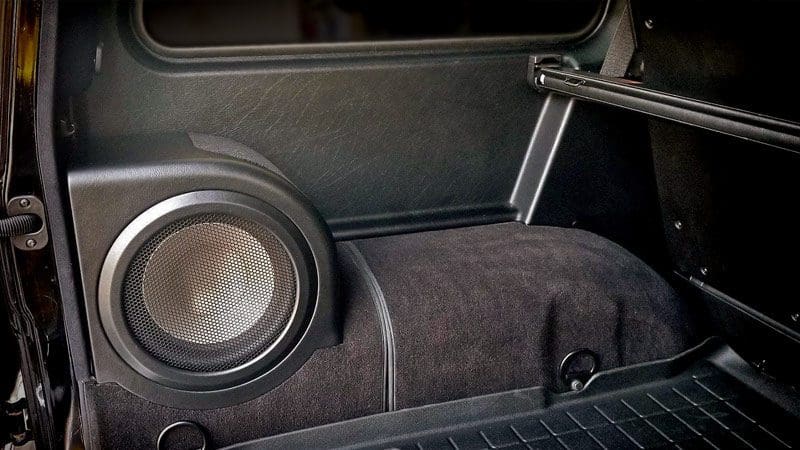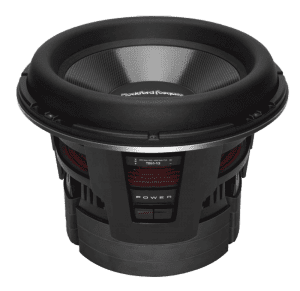 No single upgrade to an audio system offers a larger improvement in sound quality than the addition of a car audio subwoofer. Adding a subwoofer not only improves the low-frequency performance of your sound system, it can also improve the clarity of the entire system and enhance the volume level capabilities of the smaller speakers in your car. In this issue of Bang for Your Buck, we are going to look at a few popular subwoofer upgrade options available for adding bass to your vehicle.
No single upgrade to an audio system offers a larger improvement in sound quality than the addition of a car audio subwoofer. Adding a subwoofer not only improves the low-frequency performance of your sound system, it can also improve the clarity of the entire system and enhance the volume level capabilities of the smaller speakers in your car. In this issue of Bang for Your Buck, we are going to look at a few popular subwoofer upgrade options available for adding bass to your vehicle.
What is a Car Audio Subwoofer?
 In the simplest of terms, a subwoofer is a large speaker designed to play frequencies below 100 Hz at relatively high output levels. Subwoofers are most commonly available in 10- and 12-inch sizes, but 6.5-, 8-, 13.5- and 15-inch subs are also readily available.
In the simplest of terms, a subwoofer is a large speaker designed to play frequencies below 100 Hz at relatively high output levels. Subwoofers are most commonly available in 10- and 12-inch sizes, but 6.5-, 8-, 13.5- and 15-inch subs are also readily available.
To reproduce low-frequency information with authority, a speaker has to move a lot of air. In fact, for every octave lower a speaker is to play, it has to move four times as far to produce the same volume level. If your sub is moving 1 mm back and forth at 80 Hz, it has to move 4 mm at 40 Hz and an impressive 16 mm at 20 Hz. Most people find a pulsing bass line of 40–50 Hz to be fun. That said, feeling the rumble of deep bass like the introduction to “Boom Boom Pow” by the Black Eyed Peas or the pulse in Pink Floyd’s “Time” can cause goosebumps.
Subwoofer Power Handling
Most people associate subwoofers with their power-handling capabilities. While not a direct determining factor in the quality of a subwoofer, power handling is important in terms of choosing the right subwoofer for your sound system. If you want to listen to your sound system at high volume levels, you need powerful amplifiers and speakers that can handle that power while being able to move adequately to reproduce sound at high levels. It is no surprise that the output and power handling are directly related, since it takes amplifier power to make a speaker cone move.
 Picking “enough” subwoofer depends on several factors. How loud is loud enough? How much space can you afford to give the subwoofer system? How powerful of an amplifier can your vehicle’s electrical system support? It can be difficult to choose the right sub based on these criteria, especially since different vehicles offer different amounts of cabin gain. Would a single 10-inch sub in a sealed enclosure in the back of a Honda Fit be a suitable solution in a Cadillac Escalade or short-cab Ford F-150?
Picking “enough” subwoofer depends on several factors. How loud is loud enough? How much space can you afford to give the subwoofer system? How powerful of an amplifier can your vehicle’s electrical system support? It can be difficult to choose the right sub based on these criteria, especially since different vehicles offer different amounts of cabin gain. Would a single 10-inch sub in a sealed enclosure in the back of a Honda Fit be a suitable solution in a Cadillac Escalade or short-cab Ford F-150?
Custom-built Subwoofer Solutions
Your best choice to upgrade your vehicle with a subwoofer is to have your local mobile electronics specialist retailer design and construct a subwoofer system that is specific to your vehicle and your expectations. This process will start with your input in determining just how much bass you want. From there, your system designer can suggest a subwoofer or subwoofers that will meet your expectations.
 The next step is to decide where to install the subs. The simplest of custom enclosures would be a rectangular wooden cabinet that sits in the trunk or cargo area of your vehicle. The dimensions of the enclosure can be optimized to make the most use of the available space. This optimization may include angling the back of the enclosure to follow the angle of the seats.
The next step is to decide where to install the subs. The simplest of custom enclosures would be a rectangular wooden cabinet that sits in the trunk or cargo area of your vehicle. The dimensions of the enclosure can be optimized to make the most use of the available space. This optimization may include angling the back of the enclosure to follow the angle of the seats.
Depending on your goals and expectations, you may choose to have the enclosure finished in a material that matches the interior. For a more-customized look, you may want the enclosure wrapped in vinyl that is the same color and grain as the trim panels in your vehicle.
 If you want something truly unique, then ask about including LED lighting in the enclosure. You can choose to have a Lexan or Plexiglas window added and illuminate the interior of the enclosure or add acrylic plastic accent pieces that light up. Upgrades at this level are often combined with enclosures finished with multiple materials – different colors of vinyl can provide amazing cosmetics.
If you want something truly unique, then ask about including LED lighting in the enclosure. You can choose to have a Lexan or Plexiglas window added and illuminate the interior of the enclosure or add acrylic plastic accent pieces that light up. Upgrades at this level are often combined with enclosures finished with multiple materials – different colors of vinyl can provide amazing cosmetics.
Advanced Subwoofer Enclosure Designs
 The next step, beyond a simple wooden enclosure, would be one that is shaped to fit the unique contours of your vehicle. Enclosures of this type are often built using a combination of wood and fiberglass or layers of wood that are stacked one on top of another to create complex contours. The most-common application like this is where a subwoofer is being fitted into the corner of a trunk or hatch area, but is also often placed under the trunk floor in a spare tire well. The passenger-side footwell of a two-seat vehicle is another popular location for this type of enclosure.
The next step, beyond a simple wooden enclosure, would be one that is shaped to fit the unique contours of your vehicle. Enclosures of this type are often built using a combination of wood and fiberglass or layers of wood that are stacked one on top of another to create complex contours. The most-common application like this is where a subwoofer is being fitted into the corner of a trunk or hatch area, but is also often placed under the trunk floor in a spare tire well. The passenger-side footwell of a two-seat vehicle is another popular location for this type of enclosure.
Due to the complexity of these enclosures, they will typically cost more. The trade-off is that they integrate better into your vehicle – providing you with the acoustic performance you want without taking up valuable cargo area.
Application-specific Subwoofer Systems
 Companies like JL Audio, MTX and Kicker offer subwoofer systems designed for specific models of vehicles. These enclosures are designed to offer impressive performance while minimizing how much space they use. Some companies construct these enclosures from fiberglass in large molds, while others use thick plastics. In most cases, while these enclosures are visible once installed, they are available in materials that match the color of the vehicle interior. An application-specific enclosure is a great way to add amazing bass to a vehicle quickly and efficiently.
Companies like JL Audio, MTX and Kicker offer subwoofer systems designed for specific models of vehicles. These enclosures are designed to offer impressive performance while minimizing how much space they use. Some companies construct these enclosures from fiberglass in large molds, while others use thick plastics. In most cases, while these enclosures are visible once installed, they are available in materials that match the color of the vehicle interior. An application-specific enclosure is a great way to add amazing bass to a vehicle quickly and efficiently.
A subsection of these application-specific enclosures is truck boxes. No, not the thin, wedge-style enclosures that fit behind the seat, but complex enclosures that use the space under a rear bench seat in a pickup. Companies like Audio Enhancers, Bassworx and Atrend offer cost-effective solutions that will accept the subwoofer of your choice. In most of these applications, you need a shallow subwoofer because mounting depth is quite limited.
Shallow Subwoofers
 You’ll note that we haven’t discussed the specific features of subwoofers that differentiate one from another. This omission is quite deliberate because we will dedicate an entire article to that topic. In the meantime, it is worth discussing the difference between a conventional subwoofer and a shallow-mount design.
You’ll note that we haven’t discussed the specific features of subwoofers that differentiate one from another. This omission is quite deliberate because we will dedicate an entire article to that topic. In the meantime, it is worth discussing the difference between a conventional subwoofer and a shallow-mount design.
Shallow subwoofers were originally designed for use behind the seat of a pickup truck. Shallow cones, baskets and motor structures provide mounting depths of around 3 to 3.5 inches. Historically, the tradeoff for this reduced mounting depth has been a dramatic decrease in cone excursion capability. Over the past few years, companies like JL Audio, Illusion Audio, Kicker, Focal, Rockford Fosgate, ARC Audio and Audiomobile have worked hard to maximize the performance of their shallow-mount subwoofers to the point that they offer similar, if not better, performance than some conventional designs.
Audition a Subwoofer System Today!
We will leave you with this as the starting point for choosing a subwoofer solution for your vehicle. In the next article, we’ll explain the performance benefits and drawbacks of different subwoofer enclosure designs, then wrap up our buyer’s guide series with an explanation of advanced subwoofer design features that offer audible improvements in performance. Until then, visit your local specialist mobile enhancement retailer and audition one of their demo vehicles that has a subwoofer. We are sure you’ll be impressed and want one for your car or truck.
